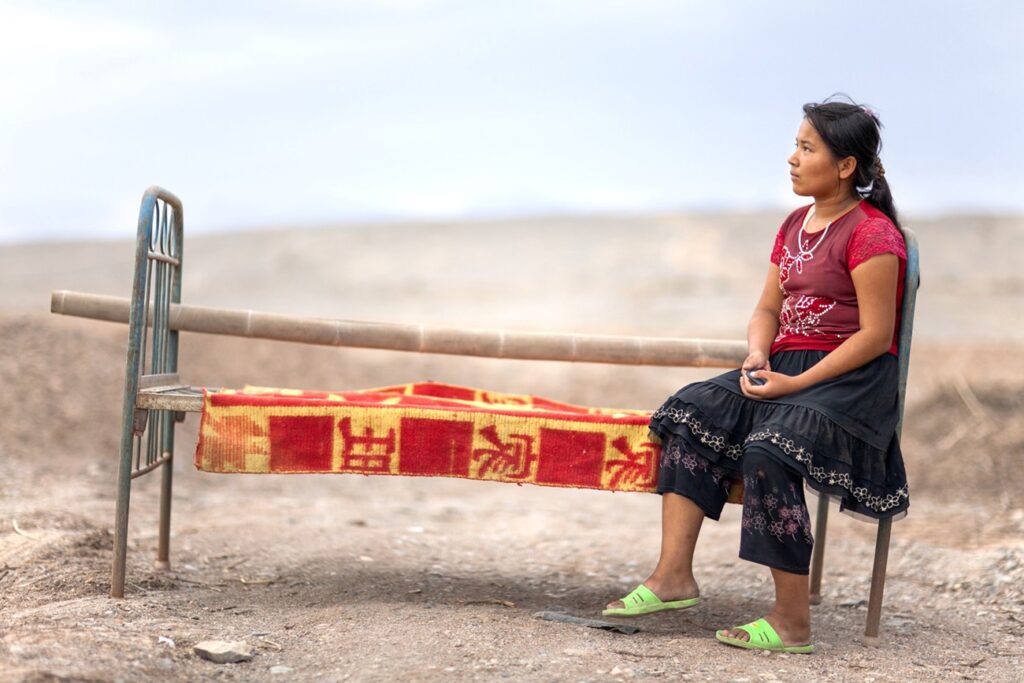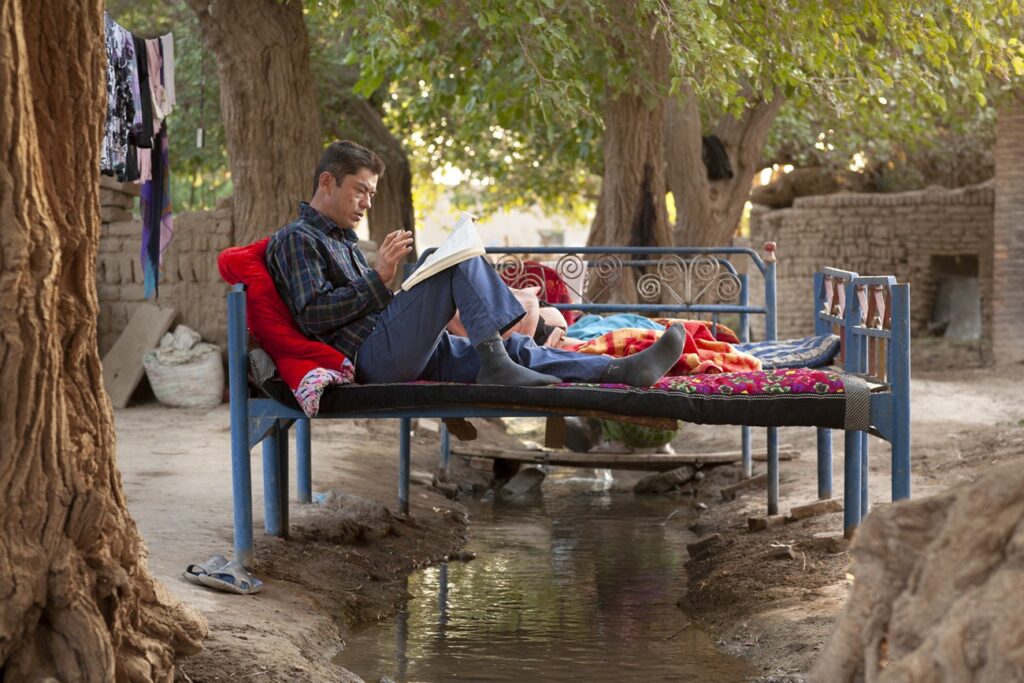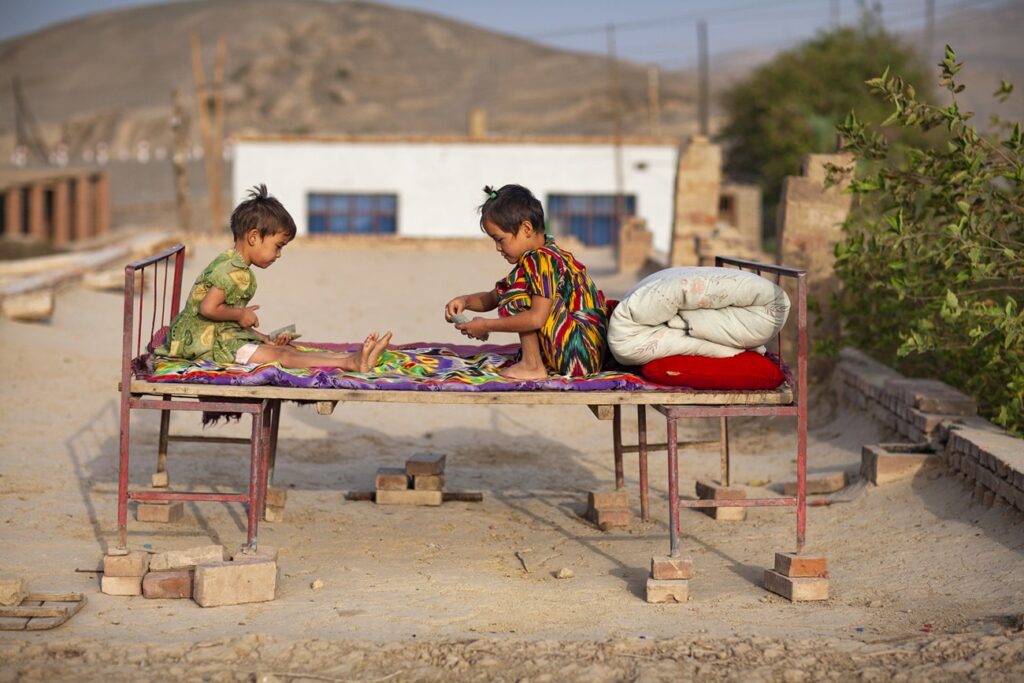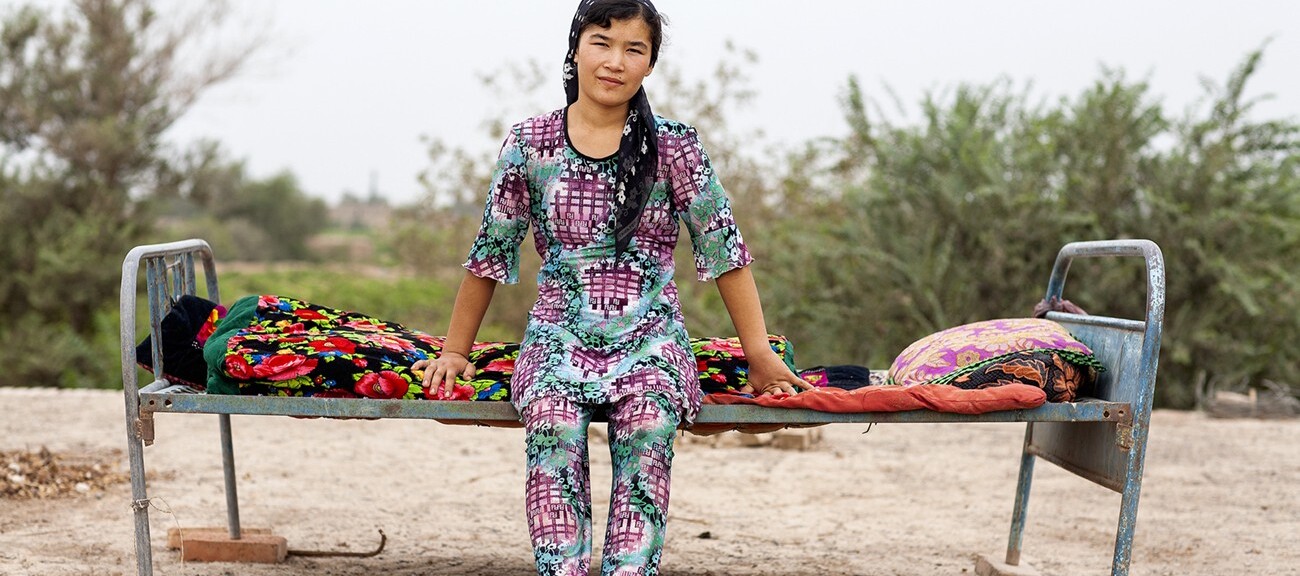قەسىدە: ئۇيغۇرنىڭ ئۇيقۇسىز چۈشلىرى






A new photography exhibition at Harvard University depicts everyday life in Xinjiang, China’s westernmost region. The photographs, taken by Lisa Ross, depict beds and their occupants outside in the open air. Sleeping outdoors is a traditional means to keep cool in the hot desert climate for many Uyghurs, Xinjiang’s Muslim-majority ethnic group. This way of life, however, is rapidly disappearing under the Chinese government’s mass detentions of many of the region’s residents.
Below is the Fairbank Center’s introduction to the exhibition, accompanied by translations in Uyghur and Chinese.
This exhibition is on display from February 25 to April 30, 2020 in CGIS South Building, 1730 Cambridge Street, Cambridge MA.
The exhibition is sponsored by the Harvard University Committee on Inner Asian and Altaic Studies, Davis Center for Russian and Eurasian Studies, Fairbank Center for Chinese Studies, and the Harvard Asia Center Arts Initiative; with support from the Provostial Fund Committee, Office of the Dean of Arts and Humanities.

Xinjiang is a region in western China that stretches from Mongolia to the Tibetan plateau, and from the Pamirs to Gansu province, forming the borderland of the People’s Republic of China with the states of Central Asia. While the lands comprising modern Xinjiang were joined together formally into a single territory only in the mid-18th c., during the Qing dynasty (CE 1636–1911), the region has for millennia enjoyed deep connections both with China and with the rest of Eurasia, involving religion, art, music, and food, as well as technology, diplomacy, conquest, and trade.
Buddhism was the dominant religion in what is now southern Xinjiang (Altishahr, also called eastern Turkestan) for most of the first millennium CE. As the result of a gradual process of Islamization beginning in the 9th and 10th centuries the region has long been home to a large Muslim population that today includes Kazakhs, Kyrgyz, Uzbeks, Tajiks, Dongxiang, and Hui, as well as the inhabitants of the oasis cities ringing the Taklamakan Desert, the people who call themselves Uyghurs. Numbering around ten million, Uyghurs are the majority ethnic group in Xinjiang, and make up approximately 43% of the population. The next largest group are the Han Chinese, who account for about 40% of those living in Xinjiang, almost all in the major cities.

The photographs by Lisa Ross displayed in this exhibition provide a moving, if disturbing, view of life for Uyghurs today. These photos were taken just before the new so-called anti-terrorist policies in Xinjiang were first being implemented. While past decades have witnessed periods of ethnic and political tension, government policies of the last two years have restricted the religious and personal freedoms of Uyghurs and other Muslims in Xinjiang to an unprecedented degree. In addition to shuttering mosques, closing schools, and bulldozing cemeteries, authorities have used extralegal means to detain an unknown number of people — perhaps as many as one million or even more — and to hold them for indefinite stretches of time in one of dozens of newly-built concentration camps, officially known as “re-education centers.” Though they do not stand accused of any crime, inmates at these facilities are unable to leave or to communicate with family and are subject to extensive questioning and political indoctrination.
Few Uyghur families have been left untouched by this campaign. Those outside the camps have seen their cultural practices criminalized, their movements incessantly tracked, and their very homes and bedrooms colonized temporarily by Chinese families who have been moved in as part of a government program that is ostensibly directed toward building ethnic harmony.
This exhibition offers the viewer the chance to reflect on the “new normal” in Xinjiang and to think about the meanings of “home.” Taken over many years, these portraits — mainly of women and children — dramatize the impact of detentions in thousands of households where loved ones have been taken away for no one knows how long. They stand by, or sit on, beds, but beds that have been removed from normal interiors and placed instead outdoors: on a road, in a field, next to a pile of bricks. Torn out of context, these beds offer little promise of rest. Surrounded by colorful sheets and blankets, many of them of native design, the figures in these photographs inhabit a dystopian dreamscape, the scenes symbolic of the uprooting of a people and a culture that is happening in real time, right before our eyes.
The richness of Harvard’s intellectual depth in Chinese studies allows us to see China in its myriad forms, including the history, culture, language, and politics of its diverse peoples and regions. This exhibition is an important addition to our classes, lectures, and educational outreach about the current distressing situation in Xinjiang, which poses dramatic challenges not just to Uyghurs, but to people everywhere in China and around the world. In times of crisis, when words are often inadequate, art and photography can best respond to the human need for expression and catharsis. We hope that this exhibition may meet those needs and remind us all of the fragility of the freedoms we enjoy every day.

قەسىدە: ئۇيغۇرنىڭ ئۇيقۇسىز چۈشلىرى
شىنجاڭ ئۇيغۇر ئاپتونۇم رايۇنى جۇڭگۇنىڭ غەربىي شىمالىي قىسمىغا جايلاشقان بولۇپ، ئۇ مۇڭغۇلىيەدىن تىبەتكىچە، پامىرئېگىزلىكىدىن گەنسۇ ئۆلكىسىگىچە سۇزۇلغان كەڭرى زېمىننى ئۆز ئىچىگە ئالىدۇ. جۇڭخۇا خەلق جۇمھۇرىيىتىنىڭ ئوتتۇرا ئاسىيا دۆلەتلىرى بىلەن بولغان چىگرىسىنى تەشكىل قىلىدۇ. گەرچە نۆۋەتتە شىنجاڭ دەپ قارىلىدىغان بۇ زېمىن پەقەت 18- ئەسىرنىڭ ئوتتۇرىدا مانجۇ خانلىقىغا رەسمى قوشىۋېلىنغان بولسمۇ، بۇ رايۇن ئۇنىڭدىن نەچچە ئەسىر بۇرۇنلا ياۋرۇ- ئاسىيا ۋە جۇڭگو بىلەن دىن، سەنئەت، يېمەك-ئىچمەك، تېخنىكا، دىپلوماتىيە، ئۇرۇش ۋە سودا قاتارلىق جەھەتلەردە قۇيۇق ئالاقە قىلىپ كەلگەن.
بۇددا دىنى ھازىرجەنۇبىي شىنجاڭ (ئالتە شەھەر، شەرقى تۈركىستان دەپمۇ ئاتىلىدۇ) دەپ ئاتىلىدىغان زېمىندا مىلادىيە 1000-يىلغىچە ئەڭ ئاساسلىق دىن ئىدى. توققۇزىنچى، ئونىنجى ئەسىردىن باشلاپ تەدرىجى ئىسلاملىشىش نەتىجىسىدە، بۇ زېمىننىڭ كۆپ قىسىم ئاھالىسى مۇسۇلمان بولدى. بۇلارنىڭ ئىچىدە ئاساسلىق ئاھالە ئۇيغۇرلار بۇلۇپ، ئۇلارنىڭ كۆپ قىسمى تەكلىماكان قۇملىقىنىڭ ئەتىراپىغا جايلاشقان بوستانلىقلاردا ياشاپ كەلگەن. ئۇيغۇرلاردىن باشقا يەنە قازاق، قىرغىز، ئۆزبېك، تاجىك، دوڭشياڭ ۋە خۇيزۇلار بار. ئۇيغۇرلارنىڭ نوپۇسى 12 مىليون ئەتىراپىدا بولۇپ، شىنجاڭدىكى نوپۇسى ئەڭ كۆپ مىللەت. تەخمىنەن ئۇمۇمى نوپۇسنىڭ 43% نى تەشكىل قىلىدۇ. ئىككىنچى ئورۇندا تۇرىدىغىنى خىتايلار بولۇپ، ئۇمۇمى نوپۇسنىڭ 40% نى تەشكىل قىلىدۇ. خىتايلارنىڭ كۆپ قىسمى شىنجاڭدىكى ھەرقايسى شەھەرلەردە ياشايدۇ.
لىسا روسنىڭ بۇ كۆرگەزمىگە قويۇلغان فوتو — سۈرەت ئەسەرلىرى ئۇيغۇرلارنىڭ نۆۋەتتىكى تۇرمۇشىنىڭ تەسىرلىك ئەمما ئېچىنىشلىق كارتىنىلىرىنى ئەكىس ئەتتۈرۈپ بېرىدۇ. بۇ سۈرەتلەر ھازىر ئېلىپ بېرىلىۋاتقان ئاتالمىش تېرورىزىمغا قارشى كەڭ كۆلەملىك باستۇرۇش باشلىنىشتىن بۇرۇن تارتىلغان. گەرچە رايۇندا نەچچە ئون يىلدىن بۇيان مىللي توقۇنۇش ۋە سىياسى بېسىم ئۈزلۈكسىز پارتىلاپ تۇرغان بولسىمۇ، ئالدىنقى ئىككى يىلدا ھۆكۈمەتنىڭ ئۇيغۇر ۋە باشقا مۇسۇلمانلارغا قاراتقان سىياسىتى، ئۇلارنىڭ دىنىي ۋە شەخسي ئەركىنلىكىنى مىسلىسىز دەرىجىدە چەكلىشى يۇقۇرى پەللىگە كۆتۈرۈلدى. مەسچىت، مەكتەپلەرنى تاقاش ۋە زەرەتگاھلىقلارنى ۋەيران قىلىپ تۈزلىۋېتىشتىن باشقا، دائىرىلەر نۇرغۇنلىغان يەرلىكلەرنى تۇتقۇن قىلدى. بەزى مۆلچەرلەرگە ئاساسلانغاندا، بىر مىلىيۇن ھەتتا ئۇنىڭدىنمۇ كۆپ كىشىلەرنەچچە يۈزلىگەن يىڭىدىن قۇرۇلغان لاگىرلاردا تۇتقۇندا. دائىرىلەر بۇ ئۇرۇنلارنى قايتا تەربىيەلەش مەركىزى دەپ ئاتايدىغان بولۇپ، گەرچە تۇتقۇنلار ھېچقانداق جىنايەت بىلەن ئەيىبلەنمىگەن بولسىمۇ، ئۇلار ئۆيىگە قايتالمايدۇ ۋە ئائىلىسىدىكىلەر بىلەن ئالاقىلىشالمايدۇ. ئۇلار تۇتقۇندا قاتتىق سورققا ۋە مېڭە يۇيۇشقا مەجبۇرلىنىدۇ.

بۇ سىياسى باستۇرۇشنىڭ تەسىرىگە ئۇچۇرىمىغان ئۇيغۇرلار يوق. لاگىرنىڭ سىرتىدىكىلەر ئۆز مەدەنىيىتىنىڭ ھۆكۈمەت تەرىپىدىن قانۇنسىزلاشتۇرۇلۇپ، ھەر بىر ھەرىكىتىنىڭ نازارەت قىلىنىپ، ئۆيىنىڭ خىتايلار تەرىپىدىن مىللەتلەر ئىتىپاقىنى باھانە قىلىپ مەجبۇرىي ئگەللىنىۋېلىشىغا دۇچار بولدى.
بۇ كۆرگەزمە قەدەم تەشرىپ قىلغۇچىلارنى شىنجاڭدىكى «يېڭى نورماللىق» ھەمدە «ئۆي» دېگەن ئۇقۇمنىڭ مەنىسى ھەققىدە ئويلاندۇردۇ. بۇ سۈرەتلەر ئاياللار ۋە بالىلارنى ئاساس قىلغان بولۇپ، ئاتا-ئانىسى، ئاكا-ئۇكىسى، ھەدە-سىڭىللىرى بىگۇناھ تۇتۇلۇپ كەتكەن نەچچە مىڭلىغان ئائىلىلەرگە كەلگەن بۇ پاجىئەنىڭ ئاقىۋىتىنى تەسۋىرلەپ بېرىدۇ. ئۇلار كارىۋاتتا ئۆرە تۇرىدۇ ياكى ئولتۇرىدۇ. ئەمما بۇ كارىۋاتلار ئەسلىدىكى نورمال ئورنى بولغان ئۆي ئىچىدە ئەمەس بەلكى تالادا: يولدا، ئېتىزلىقتا، ياكى دۆۋلەكلىك خىش-كېسەكلەرنىڭ يېنىدا. ئەسلىدىكى ئورنىدىن يۇلۇپ تاشلانغان بۇ كارىۋاتلار كىشىگە ئارام بەخىش ئەتمەيدۇ. سۈرەتتىكى يەرلىك مىللىي ئۇسلۇبتا لايىھىيلەنگەن رەڭگا-رەڭ ئەدىيال ۋە ياپقۇچلارغا ئورانغان بۇ ئادەملەرئاجايىپ مۇدھىش چۈشتە ياشاۋاتقان بولۇپ، كۆز ئالدىمىزدا ھازىرنىڭ ئۆزىدە يۈز بېرىۋاتقان يىلتىزىدىن قومۇرۇپ تاشلانغان بىر مىللەتنىڭ بىگۇناھ رېئال ھاياتىغا ۋەكىللىل قىلىدۇ.
خارۋارد ئۇنىۋېرسىتېتىنىڭ جۇڭگۇ تەتقىقاتى چوڭقۇر ھەم كەڭ دائىرىلىك بولۇپ، بىزنى جۇڭگونى ھەمدە ئۇ يەردە ياشاۋاتقان مىللەتلەر ۋە رايۇنلارنىڭ تارىخى، مەدەنىيەتى، تىلى، سىياسىتى توغرىسىدا چوڭقۇر چۈشەنچىگە ئىگە قىلىدۇ. بۇ كۆرگەزمە بىزنىڭ دەرىسلىرىمىز، لېكسىيەلىرىمىزۋە مائارىپ پروگراممىلىرىمىزغا قۇشۇلغان مۇھىم تولۇقلىما بولۇپ، بىزنىڭ نۆۋەتتىكى شىنجاڭنىڭ ئېچىنىشلىق ئەھۋالىنى تونۇشتۇرۇشىمىزغا، بۇ ۋەزىيەتنىڭ پەقەت ئۇيغۇرلارغىلا ئەمەس، بەلكى پۈتۈن جۇڭگۇ ۋە دۇنيا خەلقىگە كەلگەن ئېغىر تەھدىت ۋە ئىنسانىي كىرىزىس ئىكەنلىكىنى پۈتۈن دۇنياغا بىلدۈرۈشىمىزگە ياردىمى بار. مۇشۇنداق ئېغىر كىرزىس يۈز بەرگەن، سۆزبىلەن ئىپادىلەشكە ئاجىزلىق قىلىدىغان ۋاقىتتا، سەنئەت تىلى ئىنساننىڭ ھېسسىياتىنى ئىپادىلەش ۋە روھىي بېسىمىنى يەڭگىللىتىشكە بولغان ئېھتىياجىنى ئەڭ ياخشى قاندۇرالايدۇ. بىز بۇ قېتىملىق كۆرگەزمىنىڭ ئاشۇ ئېھتىياجلارنى قاندۇرشىنى ھەمدە بىزھەر كۈنى بەھرىمان بولىۋاتقان ئەركىنلىكنىڭ نەقەدەر ئاجىز ئىكەنلىكىنى ئەسلىتىشىنى ئارزۇ قىلىمىز.

維吾爾夢境的挽歌
新疆维吾尔自治区位于中国西部,北临蒙古、南接青藏高原,东西则连接帕米尔高原与甘肃省,构成中华人民共和国毗邻中亚诸国的边地。虽然构成现代新疆的各地区迟至十八世纪中叶才被正式划归为同一片疆域,这一地区在清朝(公元1636年-1911年)已与中国乃至整个欧亚大陆各地有着上千年的深入交往,交流的形式既包括宗教、艺术、音乐、食物、技术、外交、武力征服与贸易。
佛教是今天的南疆(即六城地区或阿尔蒂沙尔,又称东突厥斯坦)在公元第一个千年期间的主要宗教。历经九、十世纪以来渐进的伊斯兰化过程以后,该地区已拥有大量穆斯林人口。今天该地区人口包括哈萨克族、柯尔克孜族、乌孜别克族、塔吉克族、东乡族、回族,以及塔克拉玛干沙漠边缘的绿洲城市居民 — — 维吾尔人。人口约一千万的维吾尔族是新疆的多数民族,占新疆总人口的百分之四十三。位居第二的则是汉族,约占新疆人口的百分之四十,几乎都居住在新疆的大城市。
此次展出的丽莎 · 罗斯的摄影作品为我们提供了既动人心弦,却也令人不安的今日维吾尔族人的生活图景。这些照片摄于当时新的所谓新疆反恐政策的执行前夕。虽然过去的十几年这一地区也存在着民族与政治意义上的紧张局势,然而近两年的政策对维吾尔族人与其他新疆穆斯林教徒的宗教与个人自由的限制却达到了前所未有的高度。当局不仅查封清真寺、关闭学校、推毁公墓,还诉诸法外手段,在新建的数十官方称为“再教育营”的集中营内无限期扣留维吾尔等族人。关押人数不明,可能已达一百万人甚至更多。被关押的维吾尔族人虽然未被以任何罪名指控,却不能离营或与家人联系,并被迫接受无尽的审问与政治灌输。

很少维吾尔家庭能从这次运动中幸免。身处“再教育营”之外的人们,也不得不面对本土文化的风俗习惯活动被视为犯罪,一举一动被无休止地追踪的现实。政府甚至以促进民族团结的名义要求内地汉人暂时进驻维吾尔族人的私人住所。
此次展览为观众们提供机会反思新疆的“新常态”,并思考“家”的含义。这批以妇女和儿童为主体的肖像表现了成千上万家庭所遭受的冲击 — — 他们的亲属被强行带走,杳无归期。这些影像中的人物或立在床边,或坐在床上 — — 这些床铺被从室内搬到了室外:在路上,在田中,或在一堆瓦砾之侧。剥离了它们的日常环境,这些床并不能提供多少休憩的保障。影中人被色彩斑斓并且多数有着富于民族特色的床罩与毯子环绕,置身于反乌托邦式的梦境之中,象征着在我们眼前仍在持续发生的对一个民族和一种文化的连根拔起。
哈佛大学丰富而深入的中国研究使我们能够多面向地理解中国,包括各民族、各地区的历史、文化、语言和政治。此次展览为我们既有的课程、研究和教育宣传提供了重要的补充,帮助我们进一步理解新疆令人忧心的现状 — — 这不仅是维吾尔族人,也是全中国乃至全世界人民共同面对的严峻挑战。在危机时刻,言辞常显得苍白无力,艺术与摄影则能更充分地回应人类对于情感表达与精神洗礼的需要。我们希望此次展览能在满足这些需要的同时提醒观者:我们日常享受的自由也许十分脆弱。
展览时间为二零二零年二月二十五日至三月二十九日,地点位于CGIS South (1730 Cambridge Street, Cambridge MA)。
About Photographer Lisa Ross
Lisa Ross is a New York-based photographer, video artist, and educator. She received an MFA in Visual Arts from Columbia University and a BA from Sarah Lawrence College. She has taught at the Parsons School of Design, Columbia University, and the Harvey Milk School. Ross has worked on photography projects in North Africa, Central Asia, China, Europe, and Azerbaijan and has exhibited throughout the U.S. and Europe.

